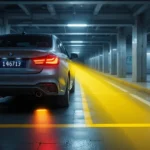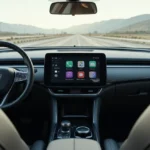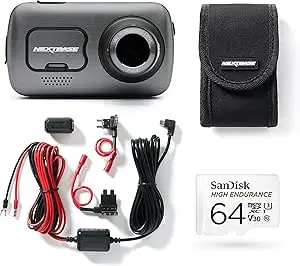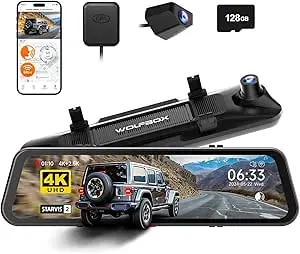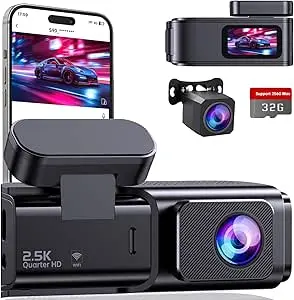In today’s unpredictable world, the open road, once a symbol of freedom, can feel surprisingly vulnerable. From parking mishaps and hit and runs to fraudulent insurance claims and unexpected incidents, the challenges facing car owners are multiplying. Proving what really happened is often stressful, time-consuming, and expensive.
Now, imagine having a silent, ever-present witness inside your vehicle, recording every moment, ready to provide clear, irrefutable evidence whenever you need it. This isn’t just about security; it’s about peace of mind, legal protection, and potentially saving thousands in insurance disputes or repair costs. In this guide, we’ll explore the world of vehicle recording devices, with a focus on two main solutions: discreet mirror dash cams and versatile traditional dash cams.
By the end of this guide, you’ll know exactly what to look for, how to compare top models, and how to choose the dash cam setup that fits your driving habits, budget, and security needs. Equip yourself to drive smarter, drive safer, and always have the evidence to back you up.
Core Benefits of Mirror & Dash Cam Protection
Undeniable Accident Evidence
Dash cam footage can be a game-changer in collision disputes. When an accident occurs, having clear video evidence removes ambiguity, showing exactly what happened and who was at fault. This can protect you from ‘crash for cash’ scams and fraudulent insurance claims, saving you stress, time, and money.
Expert Tip: Periodically Review Recorded Footage. Don’t wait for an incident to check your camera. Regularly ensure it’s recording correctly, the video quality meets your needs, and all settings are optimized.
Parking Monitoring (Hit and Runs, Vandalism)
Parking mode transforms your dash cam into a 24/7 guardian. Even when your car is unattended, it can capture evidence of damage, vandalism, or theft, giving you peace of mind wherever you park.
Expert Tip: Hardwire for True Parking Mode. For consistent round-the-clock surveillance, connect your dash cam directly to your vehicle’s fuse box. Using a hardwire kit with voltage cutoff protection, or having it professionally installed, ensures reliable operation without draining your battery.
Theft Deterrence & Vehicle Security
A visible dash cam can act as a strong deterrent against opportunistic thieves. For rideshare drivers or those lending their vehicle to others, interior recording provides an extra layer of protection, helping monitor activity inside the car.
Potential Insurance Premium Reductions & Claim Support
Many insurers recognize the value of dash cams and offer discounts to users. In addition, clear footage can speed up claim processing, giving you solid proof to support your case and minimize disputes.
General Road Safety & Incident Recording
Dash cams don’t just protect your vehicle; they document your journey. They capture road rage incidents, reckless driving, or unusual events, supporting personal accountability and even providing insights for driver improvement.
Real Life 'Saved By My Dash Cam' Stories & Scenarios
- Anonymized Anecdotes: Dash cam footage has prevented false “at fault” claims, secured insurance payouts after hit and runs, and provided crucial evidence for police investigations.
- Hypothetical Scenarios: Imagine a parked car being scratched in a lot, or an aggressive driver causing a minor collision. Having video evidence instantly turns these stressful situations into manageable ones, giving you confidence and protection in nearly any scenario.
What is a Mirror Dash Cam and How Does it Work?
Definition & Integration
A mirror dash cam is a specialized recording device designed to attach to, or sometimes replace, your vehicle’s existing rearview mirror. These devices are engineered to blend seamlessly into your car’s interior, offering a discreet and aesthetically pleasing solution compared to traditional dash cams. Their low-profile design makes them less noticeable to potential thieves while keeping your windshield clutter-free.
Core Functionality
Mirror dash cams typically offer both front and rear recording, often referred to as dual-channel functionality. This ensures coverage of both the road ahead and the area behind your vehicle. The recorded footage is displayed directly on the mirror’s surface, often via a touchscreen interface, allowing you to review video instantly or adjust settings without extra devices.
Most mirror dash cams are powered through the vehicle’s electrical system, either via a cigarette lighter adapter or a more permanent hardwire connection. Operation is generally straightforward: turn on your car, and the dash cam starts recording automatically, providing continuous surveillance with minimal setup.
What is a Traditional Dash Cam and How Does it Work?
Definition & Mounting Positions
A traditional dash cam is a standalone recording device, designed to be mounted on your windshield or dashboard. These compact units are highly versatile and can be positioned to capture optimal views of the road. Common mounting methods include suction cups for easy removal and adhesive mounts for a more permanent installation.
Fundamental Recording Capabilities
Most traditional dash cams offer front-facing recording as standard, with many models providing dual-channel options to capture both front and rear perspectives. Some units include a small dedicated screen for live viewing, while others rely entirely on a companion smartphone app for operation and settings management.
Power is typically supplied via the vehicle’s cigarette lighter socket, though hardwire kits are available for continuous recording and 24/7 parking mode. Once powered, the dash cam generally starts recording automatically, ensuring that every journey is documented without manual intervention.
Essential Features to Look For in Any Dash Cam (Mirror or Traditional)
Video Resolution & Quality (Day/Night)
Resolution determines how clearly a dash cam captures details like license plates or street signs. Common options include 1080p, 2K, and 4K. Higher resolution provides sharper images, but sensor quality and image processing are just as important. For low-light conditions, features like WDR (Wide Dynamic Range) or HDR, combined with larger apertures, improve night vision significantly. Remember, real-world clarity depends on both the sensor and how the camera processes light, not just megapixels.
Field of View (FOV)
FOV refers to the horizontal angle your camera captures, usually ranging from 140° to 170°. A wider FOV covers more lanes, but excessive width can cause fish-eye distortion. Choose a balance that captures the necessary road coverage while maintaining clear, proportional images.
Parking Mode & Battery Protection
Parking mode allows your dash cam to monitor your vehicle even when it’s off. Options include motion detection, impact detection, or time-lapse recording. For reliable 24/7 surveillance, hardwiring your dash cam is crucial. A voltage cut-off feature prevents draining your car battery during extended parking periods.
GPS & Speed Logging
GPS-enabled dash cams record your vehicle’s location and speed, which can be invaluable for accident evidence or insurance claims. Many models also allow route playback on maps, providing context for each journey.
Wi Fi & Cloud Connectivity
Wi-Fi-equipped cameras make transferring footage to your smartphone fast and easy. Premium models offer cloud access for remote live viewing or instant notifications, enhancing both convenience and security.
G Sensor (Gravity Sensor)
The G sensor detects sudden impacts and automatically locks the current video file to prevent overwriting. Sensitivity settings allow you to adjust for driving conditions, avoiding unnecessary file locks from minor bumps.
Loop Recording & SD Card Management
Dash cams record continuously, overwriting the oldest files when storage is full. Critical events can be protected using the “event” or “lock” function to prevent accidental deletion.
Expert Tip: Understand Loop Recording & File Locking. Immediately lock important footage after an incident to ensure it’s preserved.
Storage Capacity & MicroSD Card Type
High endurance microSD cards (U3/V30 rated) are essential for continuous recording, preventing data corruption. Choose a capacity that suits your desired recording duration; larger cards allow longer retention of footage.
Expert Tip: Invest in a High-Endurance MicroSD Card. Brands like Samsung Pro Endurance or SanDisk Max Endurance are reliable for constant video recording.
Capacitor vs. Battery Power
Dash cams with capacitors handle heat better and last longer than those with traditional batteries, which can swell or degrade in extreme temperatures.
Expert Tip: Prioritize Capacitors Over Batteries. Capacitors provide superior durability, especially in hot climates.
Advanced Driver Assistance Systems (ADAS)
Some dash cams offer features like Lane Departure Warning or Forward Collision Warning. While useful, evaluate whether these features are practical for your specific driving needs.
Touchscreen Interface & Ease of Use
A user-friendly interface with intuitive menus enhances your experience. Companion apps simplify footage review, settings adjustments, and downloads.
Expert Tips for Optimal Footage Quality
- Keep Lenses Clean: Dust, smudges, or condensation can reduce video clarity. Clean lenses regularly with a microfiber cloth.
- Consider a CPL Filter for Glare Reduction: A circular polarizing lens filter reduces reflections from your windshield and dashboard, improving video clarity in bright sunlight.
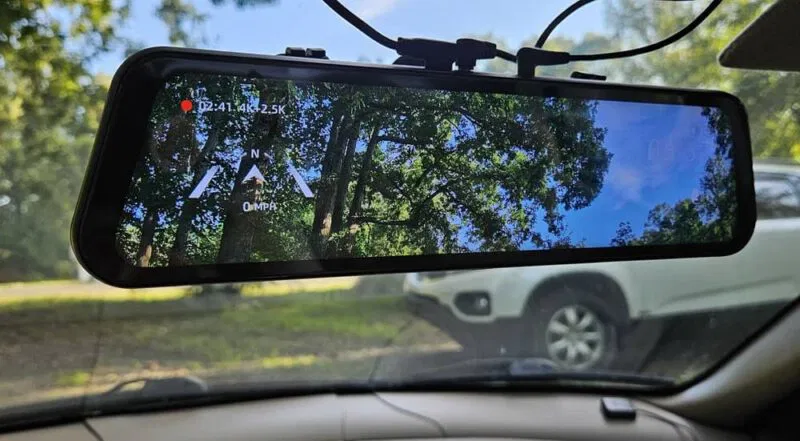
Mirror Dash Cam vs. Traditional Dash Cam: A Detailed Comparison
|
Feature / Attribute |
Mirror Dash Cam |
Traditional Dash Cam |
Ideal User / Situation |
|
Form Factor |
Replaces or clips over the existing rearview mirror. |
Compact, standalone unit mounted on windshield or dashboard. |
Mirror: Drivers who want a factory-installed look, a larger display, or who have limited windshield space. Traditional: Drivers who prefer a minimalist design or flexible mounting options. |
|
Discreetness |
Highly discreet, resembling an OEM mirror. |
It can be discreet if small and mounted behind the mirror, but still visible. |
Mirror: Ideal for those who don’t want to draw attention to the dash cam. Traditional: Suitable for drivers who prioritize flexibility over stealth. |
|
Screen Size |
Large (5–12 inches), often full-screen display for front/rear views. |
Small (1.5–3 inches) or app-controlled, sometimes no screen. |
Mirror: Drivers who want a larger, clearer rearview display or use it as a digital rearview mirror. Traditional: Drivers who prefer minimal screen distraction or rely on smartphone apps. |
|
Installation |
More complex; often requires routing cables to the fuse box for hardwiring. |
Usually simpler; plug and play via cigarette lighter, quick windshield mount. |
Mirror: Suitable for DIY savvy users or those opting for professional installation for a cleaner look. Traditional: Ideal for quick installation or temporary setups. |
|
Rear View |
Often provides superior rear visibility, especially in vehicles with obstructed rear windows. |
Typically requires a separate rear camera, often a smaller display. |
Mirror: Best for SUVs, vans, or sedans with limited rear visibility, or for digital rearview mirror functionality. Traditional: Users are primarily focused on front recording or vehicles with clear rear windows. |
|
Obstruction of View |
Replaces the existing mirror with minimal extra obstruction. |
It may obstruct part of the windshield if not positioned carefully. |
Mirror: Drivers are sensitive to windshield obstruction. Traditional: Drivers are able to mount discreetly without blocking sightlines. |
|
Cost |
Generally higher due to integrated display and advanced features. |
Wide range of prices, from budget-friendly to high-end. |
Mirror: Buyers are willing to invest more for aesthetics and added functionality. Traditional: Suitable for all budgets, from basic to premium. |
Practical Scenarios:
- Mirror Dash Cam: Perfect for a family SUV where rear visibility is limited, and the driver wants a clean, integrated look with a large rearview display.
- Traditional Dash Cam: Ideal for a compact car where the driver wants a budget-friendly setup or prefers to move the camera between vehicles.
Top Mirror & Dash Cam Recommendations for 2025
All recommendations below are based on careful analysis of technical specifications, verified user reviews from reputable sources, and expert insights. We focus on real-world performance, reliability, and value, highlighting both pros and cons to help you make an informed choice.
Best Overall High-End Options
Nextbase 622GW (Traditional)
- Key Features: 4K video, image stabilization, Emergency SOS, Alexa voice control, and What3Words integration.
- Recommendation: A benchmark for traditional dash cam excellence.
- Exceptional video quality.
- Advanced safety features.
- Robust build.
- Premium price.
- Can be bulky.
- App connectivity is occasionally finicky.
Thinkware U1000 (Traditional)
- Key Features: 4K front + 2K rear, advanced parking surveillance, cloud features, supercapacitor.
- Recommendation: Ideal for drivers seeking maximum security and parking protection
- Outstanding parking mode.
- Reliable cloud connectivity.
- Durable.
- High price.
- Requires hardwiring for full functionality.
- Setup can be complex.
Best Mirror Dash Cams
Wolfbox G850/G900 Series (Mirror)
- Key Features: Full touchscreen, 2.5K/4K front + 1080p rear, excellent night vision, GPS, parking monitor.
- Recommendation: One of the best-reviewed mirror dash cams for everyday use.
- Large.
- Clear display.
- User-friendly interface.
- Strong performance for the price.
- It may be large for some stock mirrors.
- Cable management can be tricky.
Road Angel Halo View 2 (Mirror)
- Key Features: 2K front + 1080p rear, advanced parking modes, touchscreen, GPS, G sensor.
- Recommendation: A strong choice for a premium mirror dash cam experience.
- Premium build.
- Intuitive controls.
- Excellent day and night footage.
- Higher price point.
- Minor screen glare reported by some users.
Best Value & Mid Range Options
Viofo A129 Pro Duo (Traditional)
- Key Features: 4K front + 1080p rear, supercapacitor, buffered parking mode, GPS, Wi Fi.
- Recommendation: Popular among enthusiasts for balanced performance and affordability.
- Excellent performance-to-price ratio.
- Reliable.
- Durable capacitor.
- Some models have no built-in screen (app-controlled).
- Installation can be technical.
Garmin Dash Cam 67W (Traditional)
- Key Features: Compact size, 1440p HDR, voice control, 180° FOV, automatic incident detection.
- Recommendation: Ideal for discreet installation and simplicity.
- Extremely discreet.
- Easy to use.
- Reliable brand.
- wide FOV.
- No rear camera (requires a separate unit).
- Shorter recording loops.
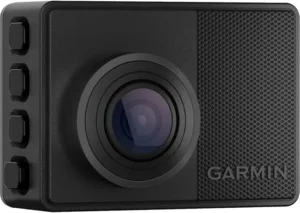
Best Budget-Friendly Option
Entry Level Models (e.g., Apeman C450, Crosstour Series) (Traditional)
- Key Features: 1080p recording, loop recording, G sensor, and basic parking mode.
- Recommendation: Great starting point for basic protection on a budget.
- Affordable.
- Covers essential recording needs.
- Lower video quality.
- Fewer advanced features.
- Less durability.
Use Case Recommendations
- Commuters: Focus on reliability, essential features, and easy access to recordings.
- Parking Security: Prioritize advanced parking modes, hardwiring, and battery protection.
- Rideshare Drivers: Emphasize interior recording, discretion, and user friendliness.
- Budget-Conscious Buyers: Ensure core functionality at an affordable price.
|
Model |
Type |
Key Features |
Resolution |
Parking Mode |
Pros |
Cons |
|
Wolfbox G850/G900 |
Mirror |
Full touchscreen, GPS, night vision, voice control |
2.5K/4K Front + 1080p Rear |
Yes (Motion/Impact) |
Large display, user friendly, strong night vision |
Can be large, cable management |
|
Road Angel Halo View 2 |
Mirror |
Premium build, GPS, advanced parking, G sensor, touchscreen |
2K Front + 1080p Rear |
Yes (Buffered/Time lapse) |
High quality, reliable, intuitive |
Higher price, minor glare |
|
Nextbase 622GW |
Traditional |
4K, image stabilization, Emergency SOS, Alexa, What3Words |
4K Front |
Yes (Intelligent) |
Exceptional video, advanced safety features, robust |
Premium price, bulky, app issues |
|
Garmin Dash Cam 67W |
Traditional |
Compact, voice control, 180° FOV, auto incident detection |
1440p HDR |
Yes (Impact) |
Extremely discreet, easy to use, and reliable |
No rear cam, shorter loops |
|
Viofo A129 Pro Duo |
Traditional |
4K Front + 1080p Rear, supercapacitor, Wi Fi, GPS |
4K Front + 1080p Rear |
Yes (Buffered) |
Excellent value, durable capacitor, clear footage |
Technical setup, app focused |
|
Thinkware U1000 |
Traditional |
4K Front + 2K Rear, advanced parking, cloud features, supercapacitor |
4K Front + 2K Rear |
Yes (Energy Saving/Motion) |
Industry leading parking, reliable cloud, durable |
High price, complex setup, hardwiring needed |
|
Apeman C450 / Crosstour |
Traditional |
1080p, loop recording, G sensor, WDR |
1080p Front |
Basic (Impact) |
Affordable, essential features |
Lower video quality, fewer features, less durable |
Installation Guide: DIY Hardwiring vs. Professional Installation
All guidance in this section is based on extensive research into common installation practices and best-case scenarios. While you’ll find step-by-step DIY instructions, we also explain when it’s best to seek professional help.
Basic DIY Installation (Plug and Play)
Mounting the Camera
- Choose the optimal spot behind the rearview mirror for discreet placement and an unobstructed view.
- Mount using suction cups for easy repositioning or adhesive mounts for a more permanent setup.
Expert Tip: Strategic Mounting for Optimal View – Position your dash cam high on the windshield to minimize dashboard reflections while maximizing coverage of the road.
Powering the Camera
- Connect the dash cam to your 12V cigarette lighter socket.
- Route cables neatly along the headliner and A pillar.
Expert Tip: Cable Management Tips – Tuck cables into trim panels or secure them with clips to maintain a clean, professional look.
Installing a Rear Camera (if applicable)
- Run cables from the front to the rear, under floor mats or along the roof lining.
- Mount the rear camera inside the rear window, typically using adhesive.
Understanding Hardwiring for Advanced Features
What is Hardwiring?
Hardwiring connects your dash cam directly to the vehicle’s fuse box, providing constant power for true 24/7 parking mode and other advanced features.
Components Needed
- Hardwire kit with voltage cut-off protection
- Fuse tap
- Multimeter (optional, for identifying fuse types)
Basic Steps for DIY Hardwiring (Overview)
- Identify constant and accessory fuses in the fuse box.
- Ground the hardwire kit to an appropriate chassis point.
- Connect the fuse taps to the chosen fuses.
DIY vs. Professional Installation Costs
- DIY Cost: Mainly the hardwire kit, typically $15–$40.
- Professional Installation Cost: Usually $50–$150 for a basic setup; more for complex or multi-camera installations. Ask installers about their experience with dash cams, warranty safety, and hidden cable routing.
When Professional Help is Advisable
- You lack experience or confidence with vehicle electrical systems.
- You want a perfectly hidden or clean installation.
- Advanced wiring is needed (multiple cameras, unusual fuse locations).
- You are concerned about warranty issues (though correctly done hardwiring rarely affects it).
Legal & Insurance Considerations for Dash Cam Owners
All guidance here is generalized and should not replace consulting local laws or reviewing specific insurance policies. Authoritative information is best sourced from government transport departments and automotive associations.
Legality of Recording
Consent Laws
- Some regions require one party consent for audio recording, while others require all parties to consent. This is particularly important for interior dash cams that capture conversations.
Public vs. Private Property
- Recording in public areas is generally legal, but there may be restrictions on capturing footage in private property or sensitive locations.
Windshield Obstruction
- Many jurisdictions have laws regarding objects that obstruct the driver’s view. Position your dash cam carefully to comply with regulations.
Expert Tip: Know Your Local Laws -Always research the specific dash cam regulations, data privacy rules, and vehicle equipment laws for your region and any countries you plan to drive through.
Data Privacy Issues (e.g., GDPR)
Personal Data
- Dash cam footage can contain identifiable individuals, license plates, or private property. Be aware of privacy regulations in your area.
Sharing Footage
- Sharing recordings publicly may be restricted. Footage is generally safe to provide to authorities or insurance companies for claim verification.
Using Footage in Accident Claims
Evidence
- Dash cam recordings can serve as admissible evidence in court or insurance claims, helping to establish fault or exonerate you.
Liability
- Clear video can definitively demonstrate who was at fault, protecting you from fraudulent claims or disputes.
Impact on Insurance Policies & Premiums
Discounts
- Some insurers offer premium reductions for vehicles equipped with dash cams.
No Claims Bonus Protection
- Video evidence can safeguard your no-claims bonus by proving your innocence in incidents.
Reporting Incidents
- Always check your insurer’s requirements for submitting dash cam footage; some may have specific formats or submission methods.
Regional Differences & Resources
- Dash cam laws vary widely. For example:
- UK & EU: Generally allowed, but GDPR rules require careful handling of personal data.
- US: Laws differ by state; some allow recording anywhere in public, others have strict consent rules.
- UK & EU: Generally allowed, but GDPR rules require careful handling of personal data.
- Recommendation: Consult your local transport authority or automotive association websites for region-specific regulations.
Maintenance & Troubleshooting Tips for Dash Cam Longevity
This section provides actionable guidance to keep your dash cam functioning reliably and extend its lifespan. Recommendations are based on hands-on experience and extensive research into common issues and product reliability.
Regular SD Card Maintenance
- Formatting: Regularly format your microSD card, ideally once a month, to prevent file errors and ensure smooth loop recording.
- Card Life: Use high endurance cards (U3/V30 rated) designed for continuous recording. Replace cards showing signs of wear or errors.
- Data Corruption: Watch for missing files, playback issues, or skipped recordings; these often indicate a failing SD card.
Firmware Updates
- Importance: Firmware updates can improve performance, add features, and fix bugs.
- Process: Check the manufacturer’s website or companion app for updates, then follow their installation instructions carefully.
Expert Tip: Regular Firmware Updates are Crucial – Keeping your dash cam firmware up to date ensures optimal functionality and reduces the risk of bugs or compatibility issues.
Cleaning Lenses & Housing
- Use a soft microfiber cloth to gently remove dust or smudges.
- Avoid harsh chemicals or abrasive materials that could scratch the lens or housing.
- Clean the windshield area in front of the lens to minimize glare and improve video clarity.
Addressing Common Issues
Camera Not Powering On
- Check all connections, including the cigarette lighter, hardwire kit, or fuse.
- Ensure the power source is functioning correctly.
Corrupted Files or Gaps in Recording
- Often caused by SD card errors. Try formatting or replacing the card with a high endurance model.
Poor Video Quality
- Clean the lens and windshield.
- Verify camera settings for resolution and exposure.
- Consider limitations in low-light conditions.
Battery Drain (Parking Mode)
- Ensure your hardwire kit has proper voltage cut-off protection.
- If battery drain persists, professional installation may be required.
Wi Fi Connectivity Problems
- Check app pairing, ensure firmware is up to date, and reset connections if necessary.
Overheating
- Mount the camera in a location with airflow, avoiding direct sunlight when possible.
- Prefer capacitors over batteries for better heat resistance and longevity.
Frequently Asked Questions:
Conclusion: Drive Protected, Drive Smart
Dash cams have become an essential part of modern vehicle protection. They provide irrefutable evidence in accidents, deter theft, support insurance claims, and give you peace of mind on every journey. Whether you choose a discreet mirror dash cam or a versatile traditional model, understanding the key features, video quality, parking mode, GPS, and connectivity ensures you select the setup that fits your driving style and security needs.
Investing in a quality dash cam is more than just an expense. It’s a proactive step toward safeguarding your vehicle, your finances, and your legal position on the road. From preventing fraudulent claims to protecting your no-claims bonus, the benefits far outweigh the initial cost.
Use this guide as your definitive resource. Consider your driving habits, your vehicle type, and your budget to make an informed decision that maximizes protection and convenience.
Call to Action: Make the smart choice for your vehicle’s security today. Explore our recommended models and drive with confidence, knowing you’re always protected.
Unique Feature: Try our interactive “Find Your Perfect Dash Cam” quiz on our website for personalized recommendations tailored to your exact needs and preferences.


